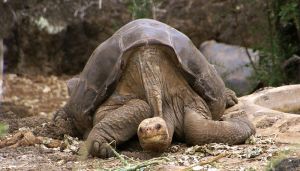Conservation news has been awash with the tragedy that is the loss of Lonesome George since 24th June 2012.
Lonesome George was the last of his subspecies Chelonoidis nigra abingdonii, better known as the Pinta giant tortoise. He had been heralded as the rarest animal on the planet, but why is it such a sad thing that one turtle dies, when this happens all the time?
The death of Lonesome George marks his sub species becoming extinct. Extinction usually happens whilst we aren’t looking, we find out afterwards that a species is likely to be extinct due to lack of sightings or reports. However the extinction of the Pinta giant tortoise happened in front of our eyes.
Although being the last of his kind, attempts were still being made to continue his species by means of mating him with females of other sub species – but to no avail.
 The decline of Tortoises in the galapagos islands was undoubtedly due to human actions – it came about with the introduction of goats, who were a detriment to the islands’ vegetation, leaving the tortoises like Lonesome George’s relatives, with little to eat. However, although Lonesome George is no more, there is a Conservation success to be told here – efforts were made to remove the goats, and the vegetation is returning to it’s former state. The overall population of Galapagos giant tortoises numbers have increased from a few thousand to over 20,000.
The decline of Tortoises in the galapagos islands was undoubtedly due to human actions – it came about with the introduction of goats, who were a detriment to the islands’ vegetation, leaving the tortoises like Lonesome George’s relatives, with little to eat. However, although Lonesome George is no more, there is a Conservation success to be told here – efforts were made to remove the goats, and the vegetation is returning to it’s former state. The overall population of Galapagos giant tortoises numbers have increased from a few thousand to over 20,000.However perhaps the fight is not over for Lonesome George’s sub-species after all – since his death it has been discovered that some of the Pinta giant tortoises’ genes live on, in the form of a hybrid between this sub species and another. By selectively breeding the hybrid tortoises with the greatest proportion of Pinta genes, they may be able to breed the Pinta giant tortoise back into existence, bringing it back from extinction – conservation of the modern age.
Is it worth the time, money and effort to do this though? Or should these resources be better spent elsewhere, conserving the habitat for other Galapagos island tortoises, allowing them to thrive and other sub species to return from being classed as “vulnerable” and move to an area of lower risk. If the resources were spent here, perhaps we would be less likely to experience again the loss that we felt for Lonesome George.
As more species become extinct, their genes are lost from gene pools and so biodiversity decreases. (See my blog: Why do we care? for the importance of biodiversity). Although it is sad to know that many species will follow in the footsteps of Chelonoidis nigra abingdonii and that many of us and our future generations will not have the pleasure of knowing them, it is the loss of biodiversity that conservationists are really fighting against. Lonesome George represented the struggle against biodiversity loss, and although the fight has not been won in this case, as one business in the Galapagos displayed “We have witnessed extinction. Hopefully we will learn from it.”